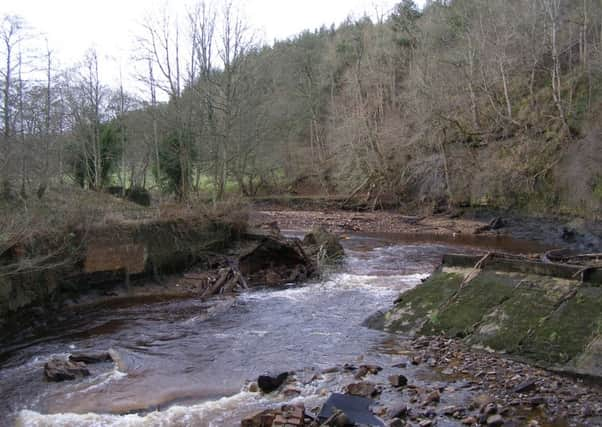The power of water along the River Esk


Built to provide water power for the gunpowder mills, the sound of the water rushing over the top was a delight and the reflections in the pool above were beautiful, especially in autumn.
Dogs enjoyed swimming in the water and many children skimmed stones across the surface. But these days are gone. The weir was breached at Christmas 2014.
Advertisement
Hide AdAdvertisement
Hide AdThe erosion continued throughout 2015 until, again at Christmas, even the stony beach was washed away, leaving an 8ft-high cliff. The power of water.
The Esk and North Esk have for centuries provided power for numerous industries along their banks, with more then 20 weirs, the first dam being near the source at the North Esk Reservoir.
Built by a consortium of mill owners in Penicuik, it helped to regulate the flow of water in the river to give a constant supply to all the paper mills which had sprung up further downstream. They had to plan ahead though – it took about eight hours for the water to flow to Penicuik.
Years before, the village of Carlops had grown to house cotton weavers. Paties Mill was originally a woollen mill but later became a corn mill.
Advertisement
Hide AdAdvertisement
Hide AdMany of the early mills were meal or flour mills. You couldn’t nip out to the supermarket to buy a loaf of bread or a bag of flour, nor could farmers pick up the phone to order a bulk load of animal feed to be delivered.
Nearly every hamlet had its own mill powered by water from a river or burn. Bread was made daily in the house kitchen or a village might have its own bakery. Farmers took sacks of grain to the miller to have the oats bruised, easier for animals to digest.
Gradually, meal mills were converted for other uses. The first paper mill at Valleyfield, Penicuik was built in 1709 by Sir John Clerk, later taken over by the Cowan family. Bank Mill, converted from corn, made special paper for bank notes and Low Mill, converted from a Waulk Mill, joined the group later. Production continued until 1975.
Further downstream, two cotton mills, Esk Mills, were also converted to make paper, closing in 1968.
Advertisement
Hide AdAdvertisement
Hide AdDalmore Mill, the last paper mill on the river to close in 2004, had been converted from meal to paper and harnessed not only water from the river but also from Glencorse burn. Many of the mills had storage reservoirs for water, some of which became wildlife ponds. Most of these sites have been redeveloped for housing.
The Encyclopaedia Britannica was printed in Edinburgh on paper made at Dalmore Mill, Edinburgh being the major centre for printing and publishing outside London in the UK with a huge demand for paper.
Auchendinny Mill produced paper for more than 100 years from 1716 but closed after a disastrous fire and became a laundry. It secured the right to do the laundry for Queen Victoria when she stayed at Holyrood. By 1905, 650 sheets could be washed at a time!
Her Highness also had linen bleached at Roslin Bleachfields which closed in 1868, just in time for the carpet factory at Lasswade to move upstream to take over the site where it stayed for 100 years.
Advertisement
Hide AdAdvertisement
Hide AdMeanwhile the Roslin Gunpowder Mills went into production in 1803 using two existing weirs at Kirkettle Mill, probably originally a corn mill, and building a new weir further downstream. These weirs were still in use when the factory closed in 1954 but steam engines had been installed in 1863.
Paper was made at Polton and Springfield Mills and so it continued down the river at Kevock and Lasswade, some converted from flour mills, all powered by water from the river.
But all this manufacture of paper brought problems – pollution. With a continuing demand for more paper, there soon became a shortage of the raw material required, cotton and linen rags. The quest for new material found esparto grass, but preparing it for making paper caused even more pollution in the river.
To reduce the effect of this, the Cowans at Penicuik built a new plant at Inveresk, closer to the sea.
Advertisement
Hide AdAdvertisement
Hide AdAnother problem of using dried grass was that it was highly combustible, as found at St Leonard’s Mill in Lasswade in 1909. Although the fire brigade set out from Edinburgh, it was soon recalled as it did not operate so far from the city! The buildings were completely destroyed. The Flour Mill, established in the 17th Century at Bridgend, Dalkeith went on fire more than once.
The Iron Mill, established in Dalkeith in 1648, had hammers driven by water power producing a range of products.
It was converted to grain at the end of the 18th century possibly when a new foundry using steam power was built.
At Musselburgh, Brunton’s Wire Mills became famous worldwide for producing cables for industry, airships, aircraft and bridges, including the Forth Bridge.
Also at Musselburgh, in 1812, James Paterson invented and patented the first machine capable of tying knots for making fishing nets.